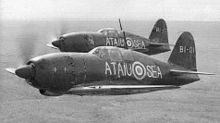Rays of the Setting Sun
Date: 23rd of April, 1945
Ttime: 1745
Weather: Clear
Location: Chiran
The island of Okinawa is engulfed in flames.
A Fight of incredible intensity ranges between our defenders and the enemy Marines. Our units are performing acts of incredible bravery holding off the enemy advance, and the staff is attempting to relieve the situation by employing special attack units against enemy warships. Tokkotai pilots take off from Southern Kiyushu and head south, where they independently search for enemy ships and attack them. These operations so far, where met with a great deal of success. Understandably, the enemy is very worried about this new kind of warfare. As they are apparently aware where the suicide flights originate from, the numbers of B-29's is seen over Southern Kiyushu has greatly increased. These lumbering Giants are aimed to destroy Tokkotai and our bases.
Mission briefing:
352nd Kokutai, equipped with the new J2M5 fighters, is given the task of defending the Southern Kiyushu from B-29’s.
At 1730 hours today early warning radar stations located a large NMB formation, heading towards our base. The formation is expected to be a group of B-29s escorted by P 51 Mustang's.
Air group headquarters ordered two flights of J2M5's to take off and intercept the bombers before they can unload it there deadly cargo on our location. Six army KI 100 fighters have already been scrambled and are on route to target. They will deal with the escort fighters.
Your object of: intercept the B 29's.
Your flight: 5 J2M5’s
Your orders:
Take off at 17:45 hours heading south west. The flight route is marked on your maps. After take off climb to 6400 m. The flight route should put you straight ahead of the formation, allowing for an initial pass. Try to aim for bombers glass cockpit after the attack, do not repeat the mistake of many young pilots and climb straight up. This would make you a perfect target for all the defense of guns in the vicinity. Instead you can dive and then split-S, executing a second fiery pass from below, or chandelle to the side, and execute a series of attacks on the beam from alternating directions.
Mitsubishi J2M
From Wikipedia, the free encyclopedia
| J2M Raiden | |
|---|---|
 | |
| Mitsubishi J2M Raiden (Allied code name "Jack") | |
| Role | Fighter aircraft |
| Manufacturer | Mitsubishi |
| First flight | 20 March 1942 |
| Introduction | December 1942 |
| Retired | August 1945 |
| Primary user | Imperial Japanese Navy |
| Number built | 671 |
The Mitsubishi J2M Raiden (雷電, "Thunderbolt") was a single-engined land-based fighter aircraft used by the Imperial Japanese Navy Air Service in World War II. The Allied reporting name was "Jack".
Contents
[hide]Design and development[edit]
The J2M was designed by Jiro Horikoshi, creator of the A6M Zero, to meet the 14-Shi (14th year of the Showa reign, or 1939) official specification. It was to be a strictly local-defense interceptor, intended to counter the threat of high-altitude bomber raids, and thus relied on speed, climb performance, and armament at the expense of manoeuvrability. The J2M was a sleek, but stubby craft with its over-sized Mitsubishi Kasei engine buried behind a long cowling, cooled by an intake fan and connected to the propeller with an extension shaft.
Teething development problems stemming from the Kasei engine cooling system, and the main undercarriage members led to a slowdown in production.[1] A continual set of modifications resulted in new variants being introduced with the ultimate high-altitude variant, the J2M4 Model 34 flying for the first time in August 1944. It had a 1,420 hp Kasei 23c engine equipped with a turbo supercharger (mounted in the side of the fuselage just behind the engine) that allowed the rated power to be maintained up to 9,100 m (29,900 ft) Two upward-aimed, oblique-firing (aimed at seventy degrees) 20 mm cannons, mounted in the German Schräge Musik style, were fitted behind the cockpit with the four wing cannons retained. Unresolved difficulties with the turbo supercharger caused the project to be terminated after only two experimental J2M4s were built.
You may also like
You may also like
Operational history[edit]
The first few produced J2M2s were delivered to the development units in December 1942 but severe problems were encountered with the engines. Trials and improvements took almost a year and the first batch of the serial built J2M2 Model 11 was delivered to 381st Kōkūtaiin December 1943. Parallel with the J2M2, production of the J2M3 Raiden Model 21 started. The first J2M3s appeared in October 1943 but deliveries to combat units started at the beginning of February 1944.
The Raiden made its combat debut in June 1944 during the Battle of the Philippine Sea. Several J2Ms operated from Guam and Saipan and a small number of aircraft were deployed to the Philippines. Later, some J2Ms were based in Chosen airfields, Genzan (Wonsan), Ranan (Nanam), Funei (Nuren), Rashin (Najin) and Konan under Genzan Ku, for defence of these areas and fighting against Soviet Naval Aviation units.
Primarily designed to defend against the Boeing B-29 Superfortress, the lack of a turbocharger handicapped the aircraft at high altitude. However, its four-cannon armament supplied effective firepower and the use of dive and zoom tactics allowed it to score occasionally. Insufficient numbers and the American switch to night bombing in March 1945 limited its effectiveness.
Two captured J2Ms were U.S. Technical Air Intelligence Command (TAIC) tested using 92 octane fuel plus methanol, with the J2M2 (Jack11) achieving a speed of 655 km/h (407 mph) at 5,520 m (17,400 ft),[2] and J2M3 (Jack21) achieving a speed of 671 km/h (417 mph) at 4,980 m (16,600 ft)

No comments:
Post a Comment